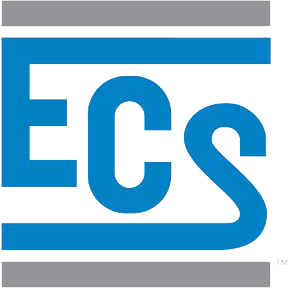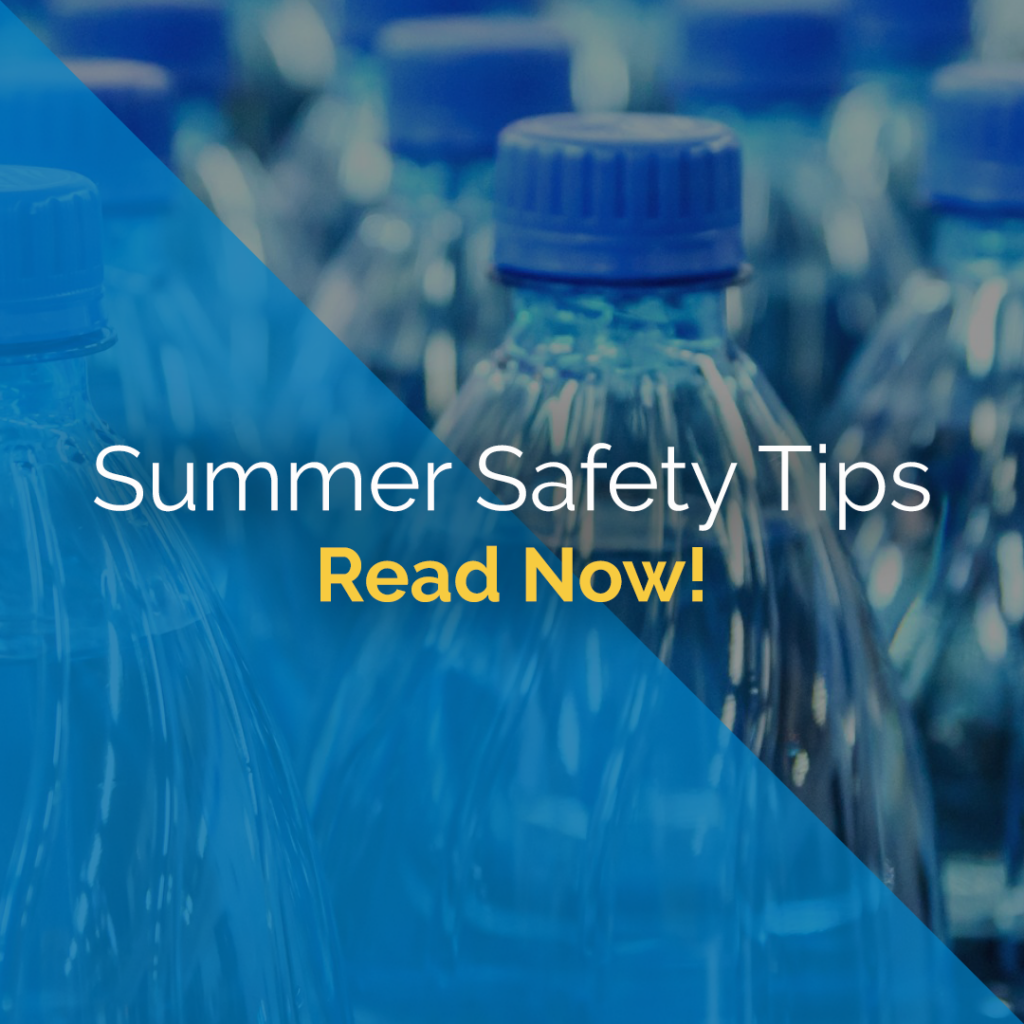We prioritize safety at ECS, and our goal is to make sure everyone goes home at the end of the day. Our STAR program is a behavior-based process in which employees observe coworkers regularly to reinforce good safety practices, as well as identify and correct unsafe practices that might lead to injury. Summer safety is no exception.
Recognizing heat illness and reacting appropriately is important in summer months, and so is taking steps to prevent heat illness from happening. We partnered with ECS Southwest’s Radiation Officer and Safety Manager, Zy Bobbitt, CWI, from our Austin, TX, office to share essential summer safety tips.
What is heat illness?
Dehydration, heat exhaustion and heat stroke are three of the most observed summer illnesses. All these heat-related illnesses are preventable.
Dehydration
Dehydration is a condition caused by the loss of too much fluid from the body. Causes of dehydration include diarrhea, vomiting, excessive sweating or urination and simply not drinking enough. Feelings of thirst are a sign that dehydration is already happening. Dehydration is a primary contributor to heat exhaustion.
Heat exhaustion
Heat exhaustion is an illness that can happen after many days of exposure to high temperatures and not enough non-alcoholic fluids. Bobbitt says that heat exhaustion is the number-one heat-related illness he typically sees during the summer at ECS. “Heat exhaustion is problematic because it exists on a spectrum. It can be slowed down if you are mindful.” Symptoms of heat exhaustion include heavy sweating, cold or clammy skin, nausea or vomiting, weakness, dizziness and fainting.
Heat stroke
The most severe of the three heat illnesses is heat stroke, which is when the body’s temperature rises quickly and cannot cool itself down. The early signs and symptoms of heat stroke can appear similar to heat exhaustion, but lead to other symptoms. The more severe symptoms of heat stroke include lack of sweating, body temperature reaching 106°F or higher within 10-15 minutes and losing consciousness.
Other dangers of working outdoors
Typically, when working in the summer, many think of the heat but forget the sun can be just as impactful. Being mindful of excessive sun exposure on the body is important because damage to the skin and eyes can lead to severe health risks. Infrared (IR) and ultraviolet (UV) radiation are silent yet important contributors to sun damage.
Infrared radiation
IR is invisible radiation in the electromagnetic spectrum. IR radiation affects the cornea to varying degrees depending on the specific wavelength. IR radiation not only affects the eyes, but it can also affect the skin as well. IR-A rays are a leading cause of premature skin aging.
Ultraviolet radiation
The sun emits two main types of UV rays: ultraviolet A (UVA) and ultraviolet B (UVB). UVA rays are associated with skin aging, whereas UVB rays are associated with skin burning, commonly referred to as sunburn. While UVA and UVB rays affect the skin differently, both can lead to skin cancers such as basal cell carcinoma and squamous cell carcinoma. Additionally, sunburn is proven to play a strong role in developing melanoma, a dangerous type of skin cancer.
There are many dangers associated with working outdoors in heat and direct sunlight. “If we address the cause before symptoms develop, we can potentially avoid an incident,” says Bobbitt.
Getting ahead of heat illness and sun damage
There are a few easy ways to manage the causes of heat illness and sun damage so that the symptoms don’t become an issue on the job.
Hydration
To avoid heat illness, it’s important to hydrate early and frequently and to continue hydrating after the workday is over. Bobbitt says, “A typical rule of thumb I like is to tell the team is to start hydrating the night before.”
Water is essential for hydration. It pulls fluid lost through sweat back into the system so that organs can function properly. On a hot day, eight ounces of water every 15-20 minutes helps battle heat illness. Per OSHA standards regarding safety and health regulations for construction, ECS provides water bottles or access to a water cooler on the job site to keep staff hydrated.
Another thing to consider when rehydrating is replacing electrolytes lost through sweat. Electrolytes help maintain the balance of fluids in the body’s cells, and, notably, regulate muscle contractions and control nervous-system function. Examples of electrolytes include potassium, manganese and sodium.
While many of these are a natural part of a well-rounded and healthy diet, in hot conditions, it may be necessary to replenish them using electrolyte-enhanced water (Smart Water, Essentia, Core Hydration), sports drinks (Gatorade, Powerade, Body Armor) or drink mixes and tablets (LMNT, Liquid IV, Nuun).
Many sports drinks contain high levels of sugar. Too much sugar can result in gastrointestinal issues which can contribute to dehydration. However, sports drinks are easy to find in grocery stores and gas stations on the way to the job site. Balancing them with plain water is important when considering overall sugar intake day to day. Drink mixes may also have sugar, but at lower levels. Remember: sugar is a carbohydrate, and carbs provide fuel for working muscles. Physical days on the job site may require the boost of a sugary sports drink to keep the body performing optimally.
Coffee, tea and many soft drinks and energy drinks contain caffeine which is a diuretic. Diuretics move extra fluid and salt out of the body. It’s best to skip drinking these on a hot or hard-effort day.
Skincare
Light-skinned people are much more susceptible to damage from UV rays than dark-skinned people, but everyone’s skin is at risk regardless of color. Protecting exposed skin is important.
There are two different types of sunscreens: chemical and physical. Chemical sunscreens, such as your average creams and sprays, are designed to absorb into the skin and only protect from UVB rays. Physical (mineral) sunscreens incorporate zinc or titanium oxide to create a barrier that sits atop the skin to prevent both UVA and UVB rays from penetrating which is why many of these products leave a white cast on the skin.
Experts recommend applying sunscreen rated SPF 30+ and reapplying throughout the day at the intervals indicated on the bottle. Easy-to-forget spots include the tops of ears, the back of the neck and the backs of hands. While the type of sunscreen used comes down to personal preference, it should be in everyone’s lunch box or work bag.
Protective apparel and accessories
There are many ways to manage moisture, temperature and sun exposure out in the field to help prevent heat illness and sun damage.
High-tech fabrics
Clothing shields skin from the sun’s harmful rays and is easier than reapplying sunscreen, but some fabrics and colors inherently offer more protection than others. For example, densely woven fabrics in dark or bright colors prevent UV rays from penetrating to the skin by absorbing them.
Realistically, working in the sun and heat in dark, dense fabrics isn’t very comfortable. Fabrics that are not inherently UPF protected can be treated with UPF technology. This is typically a chemical finish that will wash out over a period of time.
Bobbitt states that ECS Southwest offices provide long-sleeve, moisture-wicking shirts to staff. Moisture-wicking fabric is designed to pull sweat away from the skin to the surface of the fabric where it can evaporate, keeping the body dry and cool. Moisture-wicking fabrics are engineered with synthetic fibers or wool rather than cotton.
Hats and gaiters
It’s relatively easy to create shade when the real thing is in short supply. In safe zones where a hard hat isn’t required, wearing a brimmed hat helps protect the face and eyes from the sun’s damaging rays and from glare. Hats with mesh or laser-cut details in the cap enhance breathability.
A gaiter can also be worn to protect the skin from direct sun or can be rolled up with ice cubes inside and worn on the head or neck for a cooling effect.
Sunglasses
Eyes are just as susceptible to sun damage as skin. Any time safety glasses aren’t necessary, the easiest way to avoid sun damage is to wear sunglasses with UV protection. If a pair of sunglasses has UV protection, it is generally built into the lenses and marked with a label stating 100% protection against UVA and UVB or 100% protection against UV 400.
Polarized lenses are also handy because they reduce glare and eye strain.
Personal protective equipment
Personal protective equipment (PPE) minimizes exposure in risky and hazardous work environments and is required for ECS employees on the job site. ANSI-certified safety glasses without or with prescription lenses per OSHA regulations, hard hats, gloves and more are essential for a job in the field.
“ECS is leading by example with an efficient and effective safety culture,” says Bobbitt. “Being a company that cares about our employees helps clients see that we have our employees’ best interests at heart, and by extension, our clients’ best interests.” To supplement standard PPE, employees at our Southwest offices receive moisture-wicking long-sleeve shirts and visors that attach to helmets to extend protection from the sun for the ears and back of the neck.
While PPE is essential, it can contribute to heat illness. For example, hard hats and gloves retain moisture and heat because they aren’t constructed with wicking or breathable materials. This makes it that much more important to be familiar with the signs of heat illness and prepared to take steps to counteract it.
What to do when heat illness strikes
Due to demanding project timelines, there can be real or perceived pressures to work through heat and under intense sun without breaks. However, it’s very important to recognize the signs of heat illness in yourself and others and be willing to communicate the need to slow down or take a break.
The key to helping someone showing signs of heat exhaustion is to not contribute to the stress or confusion they may already be feeling. “It’s important to be very calm,” says Bobbitt. “Telling someone something is wrong with them can freak them out and make them physically feel worse. I recommend saying, ‘Hey, let’s go take a break,’ or even flipping the script and suggesting that you feel like you need a break and asking them to come with you.”
Just a few minutes stepping out of the sun to cool off, hydrate and eat a small snack can be the difference between finishing out the workday versus heading to the hospital.
At ECS, safety is everyone’s responsibility, including summer safety. Taking steps to protect yourself by preparing for heat and direct sun and recognizing the signs of heat illness in yourself and others is important to make sure everyone goes home healthy and ready to return to work the next day.
Check out our interview with Zy Bobbitt on our podcast,
Coffee Talk: From the Ground Up.

